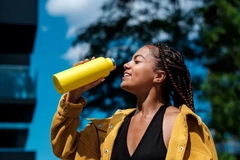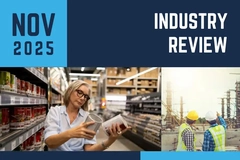
- Industry news
Industry news
- Category news
- Reports
- Key trends
- Multimedia
Multimedia
- Journal
- Events
- Suppliers
Suppliers
- Home
- Industry news
Industry news
- Category news
- Reports
- Key trends
- Multimedia
Multimedia
- Events
- Suppliers
Suppliers
Huhtamaki president: Science makes clear Quick Service Restaurant reusables carry significant environmental burden

06 Oct 2021 --- Huhtamaki has highlighted an independent study revealing that transitioning in-store Quick Service Restaurant (QSR) dining to reusable tableware would be equivalent to adding one million petrol cars to Europe’s roads.
The Life Cycle Assessment (LCA) found the reusable tableware system generates 2.8 times more CO2-equivalent emissions than the paper-based single-use system and consumes 3.4 times more freshwater.
The Finnish food packaging specialist says the publication of the updated LCA comparing single-use and reusable tableware is “a major contribution to understanding the drivers to achieving low carbon circularity and ensuring decisions affecting the future of Europe are evidence-based.”
“Despite widely held common misconceptions, today’s scientific data gives clear evidence that reusables carry significant environmental burden,” argues Eric Le Lay, president of Huhtamaki’s Fiber Foodservice Europe-Asia-Oceania business segment and current president of European Paper Packaging Alliance (EPPA).
“Based on real-life data, there is no longer any doubt paper-based single-use food packaging delivers significantly better environmental outcomes, supporting public health and European consumers.”
“We should stop the guessing game looking at environmentally viable solutions, trust the science, and work together to make our economies circular.”
Le Lay adds that having the necessary infrastructure for recycling paper-based single-use packaging in place will help Europe achieve low carbon circularity and its Green Deal goals.
According to Innova Market Insights, 52% of global consumers perceive reusable packaging as an environmentally sustainable model, followed by recyclable (50%), biodegradable (31%) and compostable (24%). The LCA found the reusable tableware system generates 2.8 times more CO2-equivalent emissions than the paper-based single-use system.
The LCA found the reusable tableware system generates 2.8 times more CO2-equivalent emissions than the paper-based single-use system.
The study in detail
The LCA was commissioned by EPPA and conducted by Ramboll, a leading global independent engineering, design and consultancy company. The study compared the environmental impacts of reusable and paper-based single-use tableware systems used for dine-in in European QSRs.
Contrary to “widely-held perceptions,” reusable tableware has “a significantly higher environmental impact” than paper-based single-use systems in areas impacting climate change, including CO2-equivalent emissions and freshwater use.
Ramboll updated its original study released in January 2021 using newly available data, concluding that the reusable tableware system generates 2.8 times more CO2-equivalent emissions than the paper-based single-use system and consumes 3.4 times more freshwater in today’s QSRs.
The reason is the amount of energy and freshwater required to wash and dry used tableware and meet the standards needed to prevent cross-contamination, especially important during a global pandemic.
Reusables and the EU Green Deal
The European Green Deal’s overarching aim is for the EU to become the world’s first “climate-neutral bloc” by 2050.
Subsequent analysis of the LCA results showed the full climate impact of shifting in-store dining to reusables in European QSRs would be equivalent to adding one million petrol cars to Europe’s roads.
The amount of freshwater used to wash the reusable tableware would equal the freshwater needs of a city of 750,000 people.
“This goes against the objectives set both by the EU’s Green Agenda and the UN’s SDG, and is of grave concern as it impedes the real need to address climate change today and the progress the packaging industry is making in developing environmentally viable packaging solutions,” says Huhtamaki.
The company calls on the EU and other global institutions to use evidence such as the Ramboll LCA to drive its decision-making. The study also found the reusable tableware system consumes 3.4 times more freshwater than the paper-based single-use system.
The study also found the reusable tableware system consumes 3.4 times more freshwater than the paper-based single-use system.
Recycling benefits
The updated study also found increasing the recycling of paper-based single-use items further reduces their environmental impact, particularly compared to many reusable tableware products that cannot be recycled or have low recycling levels.
For example, by raising the recycling rate of paper-based single-use tableware from the 30% used in the Ramboll study to 70%, the freshwater consumption advantage of paper-based packaging increases from 3.4 to 228 times better than the reusable system.
However, not all studies have come to the same conclusions. Last year, a multi-university environmental study in China found reusable takeout packaging environmentally favorable to paper-based alternatives.
Fiber-based solutions
Huhtamaki continues to roll out new fiber-based packaging solutions as industry searches for plastic waste escape routes.
The company recently launched fiber-based egg cartons in the US and Brazil and partnered with Syntegon on “industry-first” paper-based blister packs.
According to Innova Market Insights, 72% of global consumers perceive paper-based packaging as being highly recyclable.
By Joshua Poole











